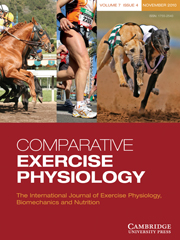Article contents
Forelimb kinematics of the flat walk and fox trot of the Missouri Fox Trotter
Published online by Cambridge University Press: 11 February 2010
Abstract
While temporal variable measurements have assisted in objectively defining and distinguishing between four-beat stepping gaits performed by gaited horses, kinematic research describing joint motion of the gaited horse is limited. The objective of this study was to measure the temporal variables and the forelimb kinematics of the flat walk and fox trot of the Missouri Fox Trotter (MFT) to provide a more comprehensive description of these gaits and to assist in distinguishing between them. Reflective markers placed along the lateral aspect of the right forelimb and the zygomatic process of the temporal bone were tracked at 60 Hz as eight MFTs were ridden at a flat walk and fox trot for ten strides. Student's paired t-tests were performed to compare means of analysed parameters between gaits on finding that the fox trot was a faster stepping gait (fox trot velocity: 3.17 ± 0.03 m s− 1, flat walk velocity: 1.75 ± 0.06 m s− 1) with a shorter stride duration (fox trot: 0.63 ± 0.03 s, flat walk: 1.17 ± 0.06 s) and greater stride frequency (fox trot: 1.59 ± 0.09 strides s− 1, flat walk: 0.09 ± 0.04 strides s− 1) than the flat walk (P < 0.05). Both gaits were performed with similar stride length (fox trot: 2.0 ± 0.03 m, flat walk: 1.95 ± 0.05 m), but the fox trot had an irregular rhythm with diagonal couplets (diagonal advanced placement: 0.10 ± 0.01 s, lateral advanced placement: 0.23 ± 0.02 s). Vertical head excursions, protraction/retraction angles and joint angle-time curves for the shoulder, elbow, carpus and forelimb fetlock were similar between gaits. Shoulder peak flexion of the fox trot occurred later in the stride (fox trot: 38 ± 5%, flat walk: 20 ± 3%; P < 0.05), but the timing of the other peak flexion and extension joint angles were similar between gaits. The fox trotting carpus flexed more (fox trot: 136 ± 3°, flat walk: 147 ± 4°) than the carpus of the flat walk (P < 0.05), but the other peak flexion and extension joint angles were comparable between gaits. Measured temporal and kinematic variables assisted in defining the fox trot and flat walk and differences between variables can be applied in distinguishing between the two gaits.
Information
- Type
- Research Paper
- Information
- Copyright
- Copyright © Cambridge University Press 2010
References
- 4
- Cited by

